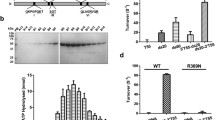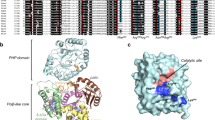Summary
Amino acid sequences of primases and associated helicases involved in the DNA replication of eubacteria and bacteriophages T7, T3, T4, P4, and P22 were compared by computer-assisted methods. There are two types of such systems, the first one represented by distinct helicase and primase proteins (e.g., DnaB and DnaG proteins of Escherichia coli), and the second one by single polypeptides comprising both activities (gp4 of bacteriophages T7 and T3, and alpha protein of bacteriophage P4). Pronounced sequence similarity was revealed between approximately 250 amino acid residue N-terminal domains of stand-alone primases and the primase-helicase proteins of T7(T3) and P4. All these domains contain, close to their N-termini, a conserved Zn-finger pattern that may be implicated in template DNA recognition by the primases. In addition, they encompass five other conserved motifs some of which may be involved in substrate (NTP) binding. Significant similarity was also observed between the primase-associated helicases (DnaB, gp12 of P22 and gp41 of T4) and the C-terminal domain of T7(T3) gp4. On the other hand the C-terminal domain of P-alpha of P4 is related to another group of DNA and RNA helicases. Tentative phylogenetic trees generated for the primases and the associated helicases showed no grouping of the phage proteins, with the exception of the primase domains of bacteriophages T4 and P4. This may indicate a common origin for one-component primase-helicase systems. Two scenarios for the evolution of primase-helicase systems are discussed. The first one involves fusion of the primase and helicase components (T7 and T3) or fusion of the primase component with a different type of helicase domain (P4). The second possibility is the duplication of an ancestral gene encoding a gp4-like bifunctional protein followed by divergence of the copies, one of which retains the primase and the other the helicase domain.
Similar content being viewed by others
References
Alberts BM (1984) The DNA enzymology of protein machines. Cold Spring Harbor Symp Quant Biol 48:1–12
Backhaus H, Petri JB (1984) Sequence analysis of a region from the early right operon in phage P22 including the replication genes 18 and 12. Gene 32:289–303
Beck PJ, Gonzalez S, Ward CL, Molineaux IJ (1989) Sequence of bacteriophage T3 DNA from gene 2.5 through gene 9. J Mol Biol 210:687–701
Bernad A, Lazaro JM, Salas M, Blanco L (1990) The highly conserved amino acid sequence motif Tyr-Gly-Asp-Thr-Asp-Ser in alpha-like DNA polymerases is required by phage ϕ29 DNA polymerase for protein-primed initiation and polymerization. Proc Natl Acad Sci USA 87:4610–4614
Bernstein JA, Richardson CC (1988a) A 7-kDa region of the bacteriophage T7 gene 4 protein is required for primase but not for helicase activity. Proc Natl Acad Sci USA 85:396–400
Bernstein JA, Richardson CC (1988b) Purification of the 56-kDa component of the bacteriophage T7 primase/helicase and characterization of its nucleoside 5′-triphosphate activity. J Biol Chem 263:14891–14899
Bernstein JA, Richardson CC (1989) Characterization of the helicase and primase activities of the 63-kDA component of the bacteriophage T7 gene 4 protein. J Biol Chem 264:13066–13073
Brodsky LI, Drachev AL, Tatuzov RL, Chumakov KM (1991) GENEBEE: a package of computer programs for biopolymer sequence analysis. Biopolim Kletka 7(1):10–14
Cha T-A, Alberts BM (1990) Effects of the bacteriophage T4 gene 41 and gene 32 proteins on RNA primer synthesis: coupling of leading- and lagging-strand synthesis at a replication fork. Biochemistry 29:1791–1798
Chumakov KM, Yushmanov SY (1988) Maximum topological similarity principle in molecular taxonomy. Mol Genet Mikrobiol Virusol 3:3–9 [in Russian]
Dunn JJ, Studier FW (1983) Complete nucleotide sequence of bacteriophage T7 DNA and the locations of T7 genetic elements. J Mol Biol 166:477–535
Felsenstein J (1989) PHYLIP 3.2 manual. University of California Herbarium, Berkeley CA
Feng DF, Johnson MS, Doolittle RF (1985) Aligning amino acid sequences: comparison of commonly used methods. J Mol Evol 21:112–125
Flensburg J, Calendar R (1987) Bacteriophage P4 DNA replication. Nucleotide sequence of the P4 replication gene and the cis replication region. J Mol Biol 196:439–445
Fry DC, Kuby SA, Mildvan AS (1986) ATP-binding site of adenylate kinase: mechanistic implications of its homology with ras-encoded p21, F-ATPase, and other nucleotide-binding proteins. Proc Natl Acad Sci USA 83:907–911
Gorbalenya AE, Koonin EV (1989) Virus proteins containing the purine NTP-binding pattern. Nucleic Acids Res 17:8413–8440
Gorbalenya AE, Blinov VM, Donchenko AP, Koonin EV (1989a) An NTP-binding motif is the most conserved sequence in a highly diverged group of proteins involved in positive strand RNA viral replication. J Mol Evol 28:256–268
Gorbalenya AE, Koonin EV, Donchenko AP, Blinov VM (1989b) Two related superfamilies of putative helicases involved in replication, recombination, repair and expression of DNA and RNA genomes. Nucleic Acids Res 17:4713–4730
Gorbalenya AE, Koonin EV, Wolf YI (1990) A new superfamily of putative NTP-binding domains encoded by genomes of small DNA and RNA viruses. FEBS Lett 00:145–148
Hatt C, Ward ME, Clarke IN (1988) Analysis of the entire nucleotide sequence of the cryptic plasmid of Chlamydia trachomatis serovar L1. Evidence for involvement in DNA replication. Nucleic Acids Res 16:4053–4067
Koonin EV, Chumakov KM, Gorbalenya AE (1990) A method for localization of motifs in amino acid sequences. Biopolym Kletka 6(6):43–48 [in Russian]
Kornberg A (1980) DNA replication. Freeman, San Francisco
Kornberg A (1982) Supplement to DNA replication. Freeman, San Francisco
Leontovich AM, Brodsky LI, Gorbalenya AE (1990) Compilation of a complete map of local similarity for two biopolymers (DOTHELIX) program of the GENBEE package. Biopolim Kletka 6(6):14–21
McMacken R, Alfano C, Gomes B, LeBowitz JH, Mensa-Wilmot K, Roberts JD, Wold M (1987) Biochemical mechanisms in the initiation of bacteriophage λ DNA replication. In: Kelly TJ, McMacken R (eds) DNA replication and recombination. Alan R. Liss, New York, pp 227–245
Nakai H, Richardson CC (1988) Leading and lagging strand synthesis at the replication fork of bacteriophage T7. J Biol Chem 263:9818–9830
Poch O, Sauvaget I, Delarue M, Tordo N (1989) Identification of four conserved motifs among the RNA-dependent polymerase encoding elements. EMBO J 8:3867–3874
Scherzinger E, Lanka E, Morelli G, Seiffert D, Yuki A (1977) Bacteriophage T7 induced DNA-priming protein. Eur J Biochem 72:543–558
Sneath P, Sokal R (1973) Principles of numerical taxonomy. San Francisco
Toh H (1986) T7 and E. coli share homology for replication-related gene products. FEBS Lett 194:245–248
Van den Ende A, Baker TA, Ogawa T, Kornberg A (1985) Initiation of enzymatic replication at the origin of Escherichia coli chromosome: primase as the sole priming enzyme. Proc Natl Acad Sci USA 82:3954–3958
Walker JE, Saraste M, Runswick MJ, Gay NJ (1982) Distantly related sequences in the a- and b-subunits of ATP synthase, myosin, kinases and other ATP-requiring enzymes and a common nucleotide binding fold. EMBO J 2:945–951
Wickner S (1984a) DNA-dependent ATPase activity associated with phage P22 gene 12 protein. J Biol Chem 259:14038–14043
Wickner S (1984b) Oligonucleotide synthesis by Escherichia coli primase in conjunction with phage P22 gene 12 protein. J Biol Chem 259:14044–14047
Wong A, Kean L, Maurer R (1988) Sequence of the dnaB gene of Salmonella typhimurium. J Bacteriol 170:2668–2675
Yushmanov SY, Chumakov KM (1988) Algorithms for construction of maximum topological similarity phylogenetic trees. Molek Genet Mikrobiol Virusol 3:3–9 [in Russian]
Author information
Authors and Affiliations
Rights and permissions
About this article
Cite this article
Ilyina, T.V., Gorbalenya, A.E. & Koonin, E.V. Organization and evolution of bacterial and bacteriophage primase-helicase systems. J Mol Evol 34, 351–357 (1992). https://doi.org/10.1007/BF00160243
Received:
Accepted:
Issue Date:
DOI: https://doi.org/10.1007/BF00160243




